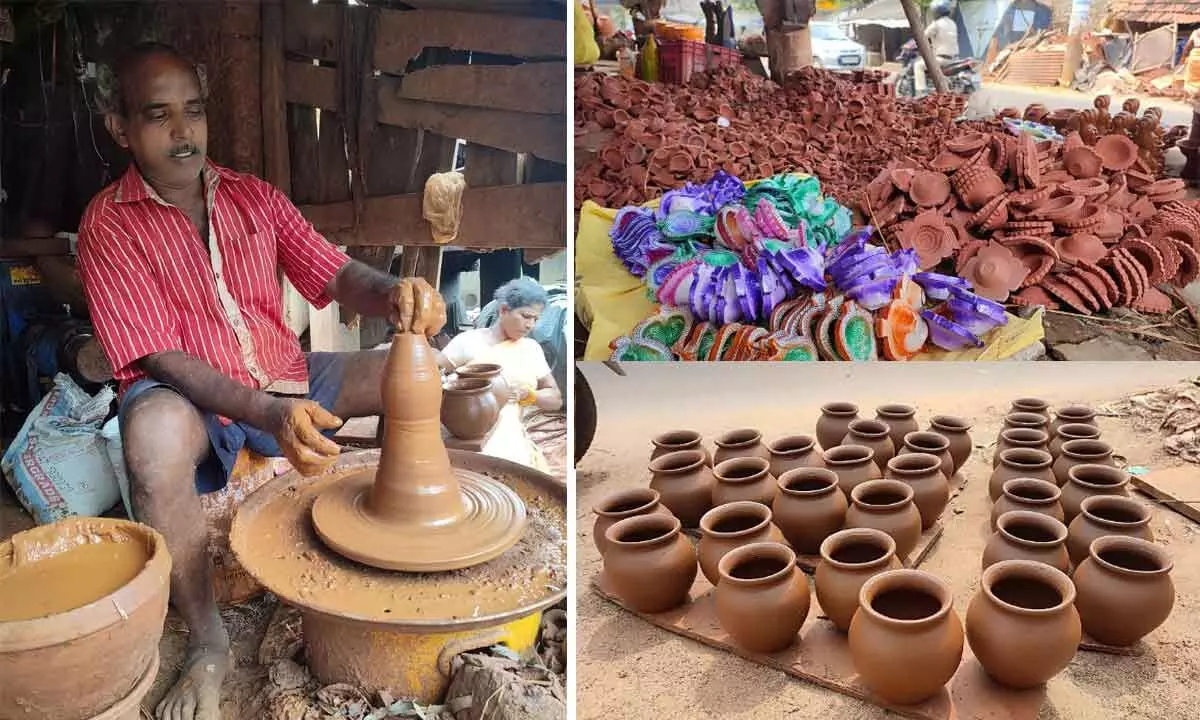Live
- Case Filed Against Actor Mohan Babu: DGP Confirms
- Devarakadra MLA Madusudhan Reddy Urges Real-Life Heroism, Criticizes Allu Arjun’s Press Meet Remarks
- Where knowledge, values and talents flourished
- Selling Stories: Shaping Businesses and Lives
- Nimrat Kaur celebrates World Saree Day with a powerful message
- AP minister orders probe into fatal accident on Addanki-Narkatpally highway
- UNICEF joins Bengal govt's efforts to combat juvenile diabetes
- Parineeti Chopra celebrates ‘Christmas on set’
- BGT: Rohit, KL Rahul suffer injury scares ahead of Boxing Day Test
- PM Modi Visits Indian Labour Camp And Engages With Diaspora In Kuwait
Just In

Assorted earthen wares designed for the festive season in Visakhapatnam
Earthen diyas gain much significance during Diwali.
Earthen diyas gain much significance during Diwali. As the festival of lights represents the triumph of good over evil, many epitomise the emergence of victory over darkness by decking up their homes with diyas, flowers and festive accessories.
Even as contemporary celebrations make way during festivals, earthen diyas, however, could not be replaced much as it still continues to be an integral part of the tradition and culture.
But the lives of potters who strive to fill the home with lamps turn out to be quite dim. For decades, hundreds of craftsmen have depended on pottery for their livelihood in Visakhapatnam.
From an earthen lamp to a huge pot and a variety of utensils and accessories, a number of products are made by churning the 'sare' potter's wheel.
Although the demand rises during wedding season, summer months and other occasions, nothing could satiate the creative pangs for the traditional potters than coming up with a variety of lamps in different shapes and sizes during Diwali.
Supermarkets, shopping malls and retail outlets offer a multitude of options for intricate lamps to pick up for the season. Even some of them are made using assorted moulds, the ethnic appearance of a bunch of handmade earthen diyas is considered irreplaceable.
At Adavivaram, Simhachalam in Visakhapatnam, Manepalli Suribabu gets busy during Diwali. For the past four decades, he has been designing a number of earthen diyas and wares for multiple purposes. Although the potter belongs to the second generation, the younger generation hardly evinces any interest in following suit. "Workload is more. Income thus generated is not sufficient either. It is one of the main reasons why not many youngsters show interest in taking the legacy forward," observes Suribabu.
His day in his village starts at 6 a.m. and continues till 8 p.m.Except for lunch and tea breaks, Suribabu engages himself throughout the day making earthen diyas, water pots, utensils, puja items, plant holders, among several other products. "Even as the Covid-19 pandemic has impacted the business at large, there is a great transformation in terms of people preferring healthy choices over unhealthy practices," notices Suribabu.
Following the healthy trend, earthen utensils make a comeback in urban kitchens. From making curd to cooking with a terracotta pan, there is an apparent rise in making the best choices as far as cooking is concerned, especially post-Covid. "Though the process of making earthen products is both time and energy consuming, the outcome eventually gives us immense pleasure," explains Venkat Rao, another potter.
With the younger generations shifting to other sources of income for obvious reasons, earthen wares continue to be incorporated for a majority of auspicious occasions even now. And it is the same reason that brings happiness to traditional potters who prefer to make a host of products by wielding a potter's wheel.
In Visakhapatnam, parts of Kummari Veedhi in Allipuram, Pandrangi in Padmanabham mandal, Jajulavanipalem, Ravada, Dondaparthi and Gorlevanipalem are some of the areas where the tradition of pottery continues.

© 2024 Hyderabad Media House Limited/The Hans India. All rights reserved. Powered by hocalwire.com







